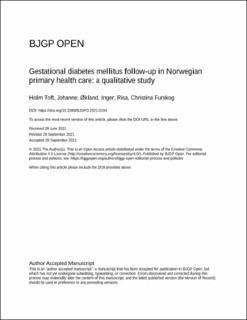| dc.contributor.author | Toft, Johanne Holm | |
| dc.contributor.author | Økland, Inger | |
| dc.contributor.author | Furskog-Risa, Christina | |
| dc.date.accessioned | 2022-01-30T15:22:52Z | |
| dc.date.available | 2022-01-30T15:22:52Z | |
| dc.date.created | 2022-01-25T11:26:24Z | |
| dc.date.issued | 2021-12 | |
| dc.identifier.citation | Toft, J.H., Økland, I., Risa, C.F. (2021) Gestational diabetes mellitus follow-up in Norwegian primary health care: a qualitative study. British Journal of General Practice Open | en_US |
| dc.identifier.issn | 2398-3795 | |
| dc.identifier.uri | https://hdl.handle.net/11250/2975757 | |
| dc.description.abstract | Background Women with gestational diabetes mellitus (GDM) have a tenfold increased risk of developing diabetes, and a high risk of recurrent GDM. Endorsing the life-course approach aiming to prevent disease and promote health across generations, the Norwegian GDM guideline recommends follow-up in primary care after delivery, with information on the increased risks, lifestyle counselling, and annual diabetes screening. Few reports exist on Norwegian women’s experiences of GDM follow-up.
Aim To elucidate women’s experiences with follow-up of GDM in pregnancy and after delivery, and to explore their attitudes to diabetes risk and motivation for lifestyle changes.
Design & setting Qualitative study in primary care in the region of Stavanger, Norway.
Method Semi-structured in-depth interviews were conducted 24–30 months after delivery with 14 women aged 28–44 years, with a history of GDM. Data were analysed thematically.
Results Most women were satisfied with the follow-up during pregnancy; however, only two women were followed-up according to the guideline after delivery. In most encounters with GPs after delivery, GDM was not mentioned. To continue the healthy lifestyle adopted in pregnancy, awareness of future risk was a motivational factor, and the women asked for tailored information on individual risk and improved support. The main themes emerging from the analysis were as follows: stigma and shame; uncertainty; gaining control and finding balance; and a need for support to sustain change.
Conclusion Women experienced a lack of support for GDM in Norwegian primary care after delivery. To maintain a healthy lifestyle, women suggested being given tailored information and improved support. | en_US |
| dc.language.iso | eng | en_US |
| dc.publisher | The Royal College of General Practitioners | en_US |
| dc.rights | Navngivelse 4.0 Internasjonal | * |
| dc.rights.uri | http://creativecommons.org/licenses/by/4.0/deed.no | * |
| dc.subject | svangerskapsdiabetes | en_US |
| dc.subject | gestational diabetes mellitus | en_US |
| dc.subject | kvinnehelse | en_US |
| dc.title | Gestational diabetes mellitus follow-up in Norwegian primary health care: a qualitative study | en_US |
| dc.type | Peer reviewed | en_US |
| dc.type | Journal article | en_US |
| dc.description.version | publishedVersion | en_US |
| dc.rights.holder | © 2021, The Authors | en_US |
| dc.subject.nsi | VDP::Medisinske Fag: 700::Klinisk medisinske fag: 750::Gynekologi og obstetrikk: 756 | en_US |
| dc.source.journal | British Journal of General Practice Open | en_US |
| dc.identifier.doi | 10.3399/BJGPO.2021.0104 | |
| dc.identifier.cristin | 1989317 | |
| cristin.ispublished | true | |
| cristin.fulltext | original | |
| cristin.qualitycode | 1 | |

